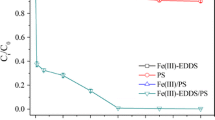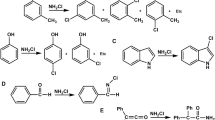Abstract
The present study elaborates the removal of endosulfan, an emerging water pollutant and potential carcinogenic, in aerated solution. The influence of Cl−, NO3 −, NO2 −, CO3 2−, HCO3 −, SO3 2−, and humic acid was assessed on the radiolytic degradation of endosulfan. A strong inhibition on the radiolytic degradation of endosulfan was observed in the presence of NO3 −, NO2 −, and SO3 2−. Instead, a slight increase in the removal efficiency of endosulfan was observed at high concentrations of CO3 2− and HCO3 −. The formation of CO3 •− in radiolytic degradation of endosulfan in the presence of CO3 2− and HCO3 − was demonstrated by adding SO3 2− that rapidly react with CO3 •−. The results indicate that CO3 •− formed from the reactions of CO3 2− and HCO3 − and commonly found in natural water can play an important role in the degradation of endosulfan and other sulfur containing electron-rich compounds. The study showed faster degradation of endosulfan at lower concentration compared to high concentration and removal was found to follow pseudo-first-order kinetic. Endosulfan ether was found as the main degradation product and degradation pathway was found to be initiated at the S=O bond of endosulfan. The efficiency of gamma irradiation in the removal of endosulfan was examined in terms of formation of short chain organic acids and chloride ion accumulation.






Similar content being viewed by others
References
Al-Sheikhly M, Silverman J, Neta P, Kapam L (1997) Mechanisms of ionizing radiation- induced destruction of 2,6-dichlorobiphenyl in aqueous solutions. Environ Sci Technol 31:2473–2477
Buxton GV, Greenstock CL, Helman WP, Ross AB (1988) Critical review of rate constants for reactions of hydrated electrons, hydrogen atoms and hydroxyl radicals (•OH/•O−) in aqueous solution. J Phys Chem Ref Data 17:513–780
Cavalcante R, da Rocha SL, Bogo D, Barbosa A, Osugi M, Blanco M et al (2013) Application of Fenton, photo-Fenton, solar photo-Fenton, and UV/H2O2 to degradation of the antineoplastic agent mitoxantrone and toxicological evaluation. Environ Sci Pollut Res 20:2352–2361
Choi D, Lee OM, Yu S, Jeong S-W (2010) Gamma radiolysis of alachlor aqueous solutions in the presence of hydrogen peroxide. J Hazard Mater 184:308–312
Földváry CM, Wojnárovits L (2009) Role of reactive intermediates in the radiolytic degradation of Acid Red 1 in aqueous solution. Radiat Phys Chem 78:13–18
Guo Z, Zhu S, Zhao Y, Cao H, Liu F (2015) Radiolytic decomposition of ciprofloxacin using γ irradiation in aqueous solution. Environ Sci Pollut Res 22:15772–15780
Jiang Y, Wang X, Jia Y, Wang F, Wu M, Sheng G, Fu J (2009) Occurrence, distribution and possible sources of organochlorine pesticides in agricultural soil of Shanghai. China J Hazard Mater 170:989–997
Khan JA, He X, Khan HM, Shah NS, Dionysiou DD (2013) Oxidative degradation of atrazine in aqueous solution by UV/H2O2/Fe2+, UV/S2O8 2−/Fe2+ and UV/HSO5 −/Fe2+ processes: a comparative study. Chem Eng J 218:376–383
Khan JA, Han C, Shah NS, Khan HM, Nadagouda MN, Likodimos V, Falaras P, O’Shea K, Dionysiou DD (2014a) Ultraviolet–visible light–sensitive high surface area phosphorous-fluorine–co-doped TiO2 nanoparticles for the degradation of atrazine in water. Environ Eng Sci 31:435–446
Khan JA, He X, Shah NS, Khan HM, Hapeshi E, Fatta-Kassinos D, Dionysiou DD (2014b) Kinetic and mechanism investigation on the photochemical degradation of atrazine with activated H2O2, S2O8 2− and HSO5 −. Chem Eng J 252:393–403
Khan JA, Shah NS, Nawaz S, Ismail M, Rehman F, Khan HM (2015a) Role of eaq −, •OH and •H in radiolytic degradation of atrazine: a kinetic and mechanistic approach. J Hazard Mater 288:147–157
Khan JA, Shah NS, Khan HM (2015b) Decomposition of atrazine by ionizing radiation: kinetics, degradation pathways and influence of radical scavengers. Sep Purif Technol 156:140–147
Lee B, Lee M (2005) Decomposition of 2,4,6-trinitrotoluene (TNT) by gamma irradiation. Environ Sci Technol 39:9278–9285
Liu Y, He X, Duan X, Fu Y, Dionysiou DD (2015) Photochemical degradation of oxytetracycline: influence of pH and role of carbonate radical. Chem Eng J 276:113–121
Lu Y, Morimoto K, Takeshita T, Takeuchi T, Saito T (2000) Genotoxic effects of α- endosulfan and β-endosulfan on human HepG2 cells. Environ Health Perspect 108:559–561
Ocampo-Pérez R, Rivera-Utrilla J, Sánchez-Polo M, López-Peñalver JJ, Leyva-Ramos R (2011) Degradation of antineoplastic cytarabine in aqueous solution by gamma radiation. Chem Eng J 174:1–8
Paul V, Balasubramaniam E (1997) Effects of single and repeated administration of endosulfan on behaviour and its interaction with centrally acting drugs in experimental animals: a mini review. Environ Toxicol Pharm 3:151–157
Pera-Titus M, Garcı́a-Molina V, Banos MA, Gimenez J, Esplugas S (2004) Degradation of chlorophenols by means of advanced oxidation processes: a general review. Appl Catal B Environ 47:219–256
Pozo K, Harner T, Wania F, Muir DCG, Jones KC, Barrie LA (2006) Towards a global network for persistent organic pollutants in air: results from the GAPS study. Environ Sci Technol 40:4867–4873
Sampa MHO, Takács E, Gehringer P, Rela PR, Ramirez T, Amro H, Trojanowicz M, Botelho ML, Han B, Solpan D, Cooper WJ, Emmi SS, Wojnárovits L (2007) Remediation of polluted waters and wastewater by radiation processing. Nukleonika 52:137–144
Sánchez-Polo M, López-Peñalver J, Prados-Joya G, Ferro-García MA, Rivera-Utrilla J (2009) Gamma irradiation of pharmaceutical compounds, nitroimidazoles, as a new alternative for water treatment. Water Res 43:4028–4036
Shah NS, He X, Khan HM, Khan JA, O’Shea KE, Boccelli DL, Dionysiou DD (2013) Efficient removal of endosulfan from aqueous solution by UV-C/peroxides: a comparative study. J Hazard Mater 263:584–592
Shah NS, Khan JA, Nawaz S, Khan HM (2014) Role of aqueous electron and hydroxyl radical in the removal of endosulfan from aqueous solution using gamma irradiation. J Hazard Mater 278:40–48
Shah NS, He X, Khan JA, Khan HM, Boccelli DL, Dionysiou DD (2015a) Comparative studies of various iron-mediated oxidative systems for the photochemical degradation of endosulfan in aqueous solution. J Photochem Photobiol A Chem 306:80–86
Shah NS, Khan JA, Nawaz S, Ismail M, Khan K, Khan HM (2015b) Kinetic and mechanism investigation on the gamma irradiation induced degradation of endosulfan sulfate. Chemosphere 121:18–25
US EPA (2002) Office of prevention pesticides and toxic substances, endosulfan red facts. US Environmental Protection Agency, Washington DC, USA
Verma A, Ali D, Farooq M, Pant AB, Ray RS, Hans RK (2011) Expression and inducibility of endosulfan metabolizing gene in Rhodococcus strain isolated from earthworm gut microflora for its application in bioremediation. Bioresour Technol 102:2979–2984
Wandiga SO (2001) Use and distribution of organochlorine pesticides: the future in Africa. Pure App Chem 73:1147–1155
Wu C, Linden KG (2010) Phototransformation of selected organophosphorus pesticides: roles of hydroxyl and carbonate radicals. Water Res 44:3585–3594
Acknowledgment
The authors are thankful to the Higher Education Commission Pakistan (HEC) for fellowship for higher study (to NSS) and research project grant (to HMK). The authors are also thankful to the Nuclear Institute for Foods and Agriculture (NIFA) authorities for permission to use gamma irradiation facility for this project.
Author information
Authors and Affiliations
Corresponding authors
Additional information
Responsible editor: Bingcai Pan
Highlights
• Removal of endosulfan was assessed by gamma irradiation in aerated solution.
• Superoxide and carbonate radical played significant role in endosulfan degradation.
• Removal efficiency and dose constant decreased with increasing endosulfan concentration.
• By-products and short chain organic acids were evaluated.
• Gamma radiation proved to be effective in toxicity reduction of chlorinated compounds.
Rights and permissions
About this article
Cite this article
Shah, N.S., Khan, J.A., Al-Muhtaseb, A.H. et al. Gamma radiolytic decomposition of endosulfan in aerated solution: the role of carbonate radical. Environ Sci Pollut Res 23, 12362–12371 (2016). https://doi.org/10.1007/s11356-016-6415-9
Received:
Accepted:
Published:
Issue Date:
DOI: https://doi.org/10.1007/s11356-016-6415-9




